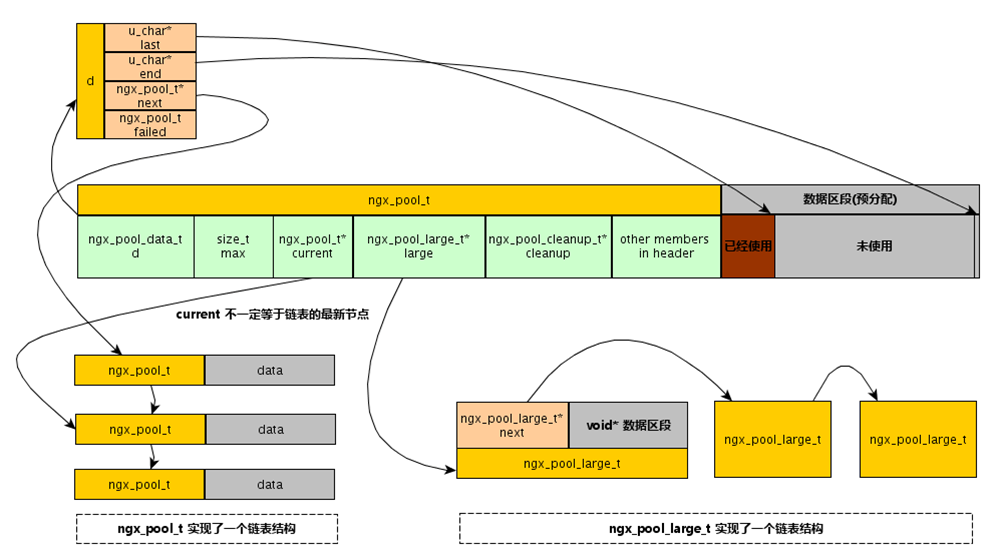内存分配相关
1.系统功能封装
内存相关的操作主要在os/unix/ngx_alloc.{h,c} 和 core/ngx_palloc.{h,c}中。
其中os/unix/ngx_alloc.{h,c}封装了最基本的内存分配函数,是对c原有的malloc/free/memalign等函数的封装,对应函数为:
a.ngx_alloc:对malloc进行了简单的封装;
void *
ngx_alloc(size_t size, ngx_log_t *log)
{
void *p;
p = malloc(size);
if (p == NULL) {
ngx_log_error(NGX_LOG_EMERG, log, ngx_errno,
"malloc(%uz) failed", size); }
ngx_log_debug2(NGX_LOG_DEBUG_ALLOC, log, 0, "malloc: %p:%uz", p, size);
return p;
}
b.ngx_calloc:使用ngx_alloc分配内存,并且把内存赋值0:
void *
ngx_calloc(size_t size, ngx_log_t *log)
{
void *p;
p = ngx_alloc(size, log);
if (p) {
ngx_memzero(p, size); }在core/ngx_string.h中定义
// #define ngx_memzero(buf, n) (void) memset(buf, 0, n) 初始化为0
return p;
}
c. ngx_memalign 返回基于一个指定的alignment大小的数值为对齐基数的空间
d.ngx_free 内存释放操作
2. nginx内存池
为了方便系统模块对内存的使用,方便内存的管理,nginx自己是信了进程池机制来进行内存的分配和释放,首先nginx会在特定的生命周期帮你统一建立内存池,当需要进行内存分配的时候同一通过内存池中的内存进行分配,最后nginx会在适当的时候释放内存吃的资源,开发者只要在需要的时候对内存进行申请即可,不用过多考虑释放的问题,这也就是在os/unix/ngx_alloc.c文件中没有看到free操作的原因吧。
下面来看一下内存池的主要结构:
ngx_palloc.h
struct ngx_pool_s {
ngx_pool_data_t d;
size_t max;
ngx_pool_t *current;
ngx_chain_t *chain;
ngx_pool_large_t *large;
ngx_pool_cleanup_t *cleanup;
ngx_log_t *log;
};
typedef struct {
u_char *last;
u_char *end;
ngx_pool_t *next;
ngx_uint_t failed;
} ngx_pool_data_t;
ngx_core.h
typedef struct ngx_pool_s ngx_pool_t;
typedef struct ngx_chain_s ngx_chain_t;

下面是几个比较重要的操作
src/core/ngx_palloc.c
//创建内存池
ngx_pool_t *
ngx_create_pool(size_t size, ngx_log_t *log)
{
ngx_pool_t *p;
p = ngx_memalign(NGX_POOL_ALIGNMENT, size, log); //创建对其空间
if (p == NULL) {
return NULL;
}
p->d.last = (u_char *) p + sizeof(ngx_pool_t); //初始指向ngx_pool_t结构体后面
p->d.end = (u_char *) p + size; //整个结构体的结尾
p->d.next = NULL; //没有next
p->d.failed = 0;
size = size - sizeof(ngx_pool_t); //剩余大小
p->max = (size < NGX_MAX_ALLOC_FROM_POOL) ? size : NGX_MAX_ALLOC_FROM_POOL;//最大不超过NGX_MAX_ALLOC_FROM_POOL
//#define NGX_MAX_ALLOC_FROM_POOL (ngx_pagesize - 1)
p->current = p;
p->chain = NULL;
p->large = NULL;
p->cleanup = NULL;
p->log = log;
return p;
}
//销毁内存池
void
ngx_destroy_pool(ngx_pool_t *pool)
{
ngx_pool_t *p, *n;
ngx_pool_large_t *l;
ngx_pool_cleanup_t *c;
for (c = pool->cleanup; c; c = c->next) {//如果注册了clenup(一种链表结构),会依次调用clenup的handler进行清理
if (c->handler) {
ngx_log_debug1(NGX_LOG_DEBUG_ALLOC, pool->log, 0,
"run cleanup: %p", c);
c->handler(c->data);
}
}
for (l = pool->large; l; l = l->next) { //遍历链表,释放所有large内存
ngx_log_debug1(NGX_LOG_DEBUG_ALLOC, pool->log, 0, "free: %p", l->alloc);
if (l->alloc) {
ngx_free(l->alloc);
}
}
#if (NGX_DEBUG) //等译debug级别,如果为true,会打印日志
/*
* we could allocate the pool->log from this pool
* so we cannot use this log while free()ing the pool
*/
for (p = pool, n = pool->d.next; /* void */; p = n, n = n->d.next) {
ngx_log_debug2(NGX_LOG_DEBUG_ALLOC, pool->log, 0,
"free: %p, unused: %uz", p, p->d.end - p->d.last);
if (n == NULL) {
break;
}
}
#endif
for (p = pool, n = pool->d.next; /* void */; p = n, n = n->d.next) {//遍历链表 ,释放内存空间
ngx_free(p);
if (n == NULL) {
break;
}
}
}
//重置内存池
void
ngx_reset_pool(ngx_pool_t *pool)
{
ngx_pool_t *p;
ngx_pool_large_t *l;
for (l = pool->large; l; l = l->next) { //释放掉所有large段内存
if (l->alloc) {
ngx_free(l->alloc);
}
}
pool->large = NULL;
for (p = pool; p; p = p->d.next) {
p->d.last = (u_char *) p + sizeof(ngx_pool_t);将指针重新指向ngx_pool_t(和创建时一样)
}
}
//从内存池里分配内存
void * ngx_palloc(ngx_pool_t *pool, size_t size)
void * ngx_pnalloc(ngx_pool_t *pool, size_t size)
void * ngx_pmemalign(ngx_pool_t *pool, size_t size, size_t alignment)
void * ngx_pcalloc(ngx_pool_t *pool, size_t size)
这里以ngx_palloc为例讲解,其他大同小异:
void *
ngx_palloc(ngx_pool_t *pool, size_t size)
{
u_char *m;
ngx_pool_t *p;
if (size <= pool->max) { //判断分配内存是否大于pool->max,如果小于等于
p = pool->current; //尝试从链表的current开始遍历,
do {
m = ngx_align_ptr(p->d.last, NGX_ALIGNMENT);
//#define ngx_align_ptr(p,a)
//(u_char *) (((uintptr_t) (p) + ((uintptr_t) a - 1)) & ~((uintptr_t) a - 1))
if ((size_t) (p->d.end - m) >= size) { //当找到可以分配的空间时
p->d.last = m + size;
return m; //分配内存后返回
}
p = p->d.next;
} while (p);
return ngx_palloc_block(pool, size);//如果无法分配内存,就生成一个新的节点,同时pool->current指针指向新的位置
}
return ngx_palloc_large(pool, size); //如果分配的内存大于pool->max则在large链表分配一段内存
}
//释放指定的内存
ngx_int_t
ngx_pfree(ngx_pool_t *pool, void *p){
ngx_pool_large_t *l;
for (l = pool->large; l; l = l->next) {
if (p == l->alloc) { //存在alloc注册
ngx_log_debug1(NGX_LOG_DEBUG_ALLOC, pool->log, 0,
"free: %p", l->alloc);
ngx_free(l->alloc);
l->alloc = NULL;
return NGX_OK;
}
}
return NGX_DECLINED;
}//由代码可以看出,这个操作只有在内存large链表里面注册内存才会真正释放,如果分配的是普通的内存,则会在destory_pool的时候统一释放。
//注册cleanup回调函数
ngx_pool_cleanup_t *
ngx_pool_cleanup_add(ngx_pool_t *p, size_t size)
{
ngx_pool_cleanup_t *c;
c = ngx_palloc(p, sizeof(ngx_pool_cleanup_t)); //分配cleanup空间
if (c == NULL) {
return NULL;
}
if (size) {
c->data = ngx_palloc(p, size); //为cleanup结构体分配data空间
if (c->data == NULL) {
return NULL;
}
} else {
c->data = NULL;
}
c->handler = NULL;
c->next = p->cleanup;
p->cleanup = c; // 增加cleanup
ngx_log_debug1(NGX_LOG_DEBUG_ALLOC, p->log, 0, "add cleanup: %p", c);
return c; //返回结构体分配的空间
}
分享到:










相关推荐
Nginx 源码分析笔记 自己的源码分析笔记,未完。
自己的nginx源码学习资料,包含《Nginx模块开发指南》和《深入理解Nginx》等,方便初学者了解nginx设计思想以及源码
mac无坑安装nginx(csdn)————程序
nginx源码分析nginx源码分析nginx源码分析nginx源码分析nginx源码分析nginx源码分析nginx源码分析nginx源码分析nginx源码分析nginx源码分析
nginx源码说明;其他下载即可,没下载分了,大家互相帮忙。其他情况大概就这些吧,其他也没什么好说的了,看文档即可
nginx源码nginx源码nginx源码nginx源码nginx源码nginx源码nginx源码nginx源码nginx源码nginx源码
nginx学习笔记.zip
nginx笔记nginx笔记nginx笔记nginx笔记nginx笔记nginx笔记nginx笔记nginx笔记
nginx源码分析,整合网络资源精彩呈现,分析的很详细,并附有源码解释,作者:http://blog.csdn.net/kenbinzhang
nginx代理 从入门到实践 详细讲解分析,入门到精通,满足企业部署,反向代理,静态资源部署,并发
Nginx学习笔记
nginx源码分析,分析过程中将重要的部分进行了注释,以便理解
收集的 nginx 源码 解析 ,非常全 architecture.png Emiller的Nginx模块开发指南.docx Nginx(en).pdf nginx@taobao.pdf nginx_internals.pdf nginx核心讲解(0.2).doc nginx核心讲解(0.4).doc Nginx模块开发指南中文...
搭建nginx php时参考的网页,具体搭建过程见我的博客
本书详细介绍了Nginx的进程模型,内存管理,request请求的解析,handler的处理等
带有详细注释的nginx源码,能帮你有效地阅读和学习nginx源码
这是我自学nginx的学习笔记,上传只是为了更好的督促自己学习,如果你也有同感,加入一起学习吧。
Nginx教程
本人在银行工作,基于生产环境搭建方法编写的Nginx源码安装手册,生产环境可参考此手册。
nginx-rtmp + ffmpeg;rtsp视频转流所需工具;livepush.war包